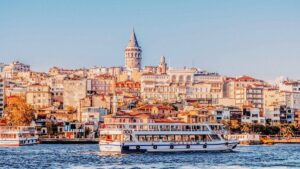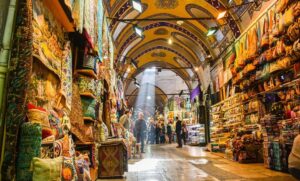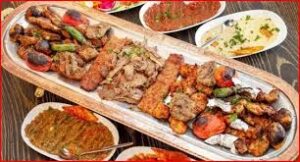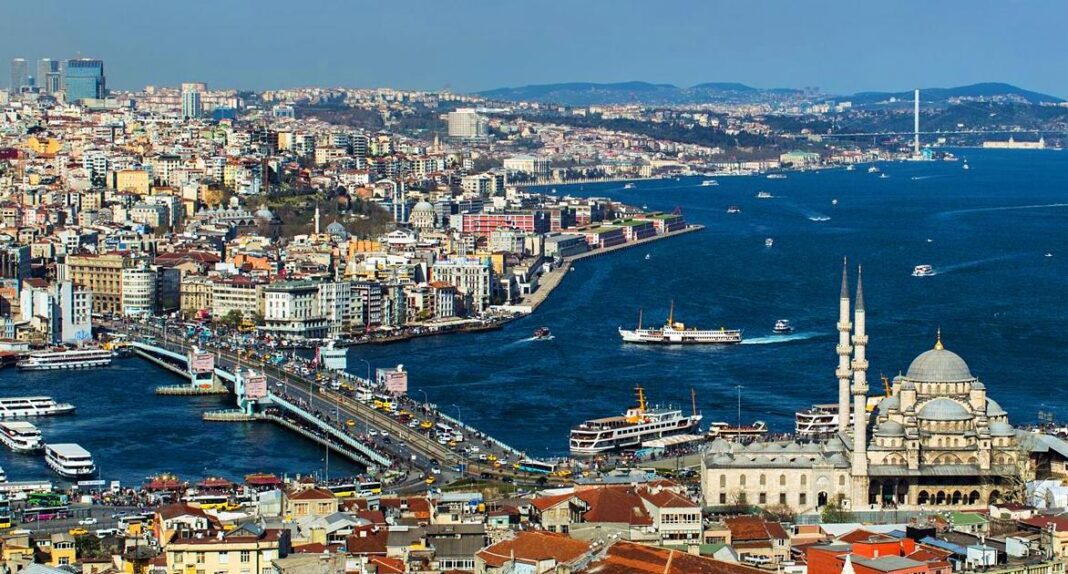ISTANBUL:

Istanbul (Turkish İstanbul – [istanbul]) is the largest city in Turkey, the main commercial, industrial and cultural center, the main port of the country. Located on the shores of the Bosphorus Strait, dividing it into the European (main) and Asian parts, connected by sea.
Istanbul is confusing at first. The city is larger in size than Moscow with a population of 15 million and is replete with contrasts: such an authentic, shabby, Muslim, hilly and chaotic Asian side and such a modern, high-rise, commercial, high-tech European side. Istanbul is teeming with people. Friendly Turks, assertive traders, independent Muslim women and pot-bellied businessmen – they all mix in the scenery of the city and it seems that you are in Turkish Manhattan. How, after all, to understand this attractive confusion of the city? In order, and it’s worth starting from the Asian side.
The historical Sultan Ahmet at first seems too “prehistoric”. Climbing along the sloping cobblestone streets, you can see scenes from the daily life of the locals. Clotheslines with colorful things like garlands decorate the narrow alleys where bearded Turks sip Turkish coffee and play chess while lazy cats watch them. Shoemakers make boots, sellers sell carpets, sloths and rich people smoke hookahs – in general, the pace of life here, compared to the modern center, is measured and lazy. There are suspiciously few women around and too many men, so if you are traveling with a female group, it is better to choose a hotel in another area, and you will not have to puff up climbing hilly roads.
Exceptional Istanbul:
To get around in the old city, there is a tram on the main street, but given the passenger flow, it is better to move between attractions on foot, although the distances may be worse than in Moscow. In any case, take a day to explore the “historical pearls” of the old part of “Constantinople”:
Mosques and cathedrals.

A classic tour is visiting all the main religious places in the city. But just imagine if, upon arrival in Moscow, tourists frantically examined every church in the city? So I would focus on the two main “shrines” of Istanbul – the Blue Mosque of Sultanahmet and the Hagia Sophia (Aya Sophia), especially since they are located opposite each other. And although the carpets are rarely washed there after barefoot worshipers and tourists, it’s stuffy inside, and the queues to enter are daunting, in all other respects, these are, of course, the most beautiful Muslim mosques I’ve ever seen.
Yerebatan sarnıcı.

One of the 40 cisterns in the city where drinking water was stored during the times of ancient Constantinople. And although the guidebooks state that it is worth going there to see the most ancient sculpture of the inverted head of the Gorgon Medusa, the most interesting part of Yerebatan is its “inhabitants”. In a dungeon the size of a concert hall, in which the ceilings are supported by 336 antique columns, water is still stored, which has become the home of a huge flock of well-fed meter-long crucian carp. The depth of the reservoir in the tank is no more than a meter, so huge fish often organize a parade or a public fight for bread. The guards don’t keep a close eye on this, so you can sneak in half a loaf of bread and create a fish circus!
Bazaars.

Going to the Grand Bazaar or the Egyptian Bazaar for shopping is like going to GUM in Moscow and buying caviar. Endlessly long rows of surprisingly expensive Turkish fake rubbish, mountains of spices and garlands of ethnic lanterns – you want to take pictures more than buy them. The markets are completely designed for tourists, and the sellers are geared towards “hypnotic sales”, so there is a risk even for the most conscientious travelers of being left without a penny, but with two kilograms of not very fresh Turkish delight.
Exceptional Istanbul
Meat lunch.

Dine on real Turkish kebab. Yes, and don’t expect to taste fresh Bosphorus fish or a plate of exquisite seafood, since for some reason there is no culture of serving and serving dishes in Istanbul (despite the well-known abundance of buffets in Turkish hotels). The menu in all ordinary restaurants is approximately the same, and so are the products. The fish markets of Kumkapi and Karakoy, praised by guidebooks, also do not help, since they are more designed for wholesale buyers and the only thing you can eat there on the spot is a fish sandwich, which threatens heartburn. What remains to be done is either to read about a good restaurant on the Internet (but it will probably be on the other side of the city), or not to bother with aesthetics and dine in an average restaurant, but with a view of the strait (a whole chain of such restaurants is located under the Galata Bridge ). Well, for absolute aesthetes, I advise you to go up to one of the rooftop restaurants, of which there are quite a few in the center, and, while starving, sip bitter Turkish coffee, admiring the sharp minarets of the Blue Mosque.
Hammam.

Cleansing your soul and body in a local hammam is the most important part of a trip to Istanbul. Firstly, because not a single Turkish hotel washed you the way they wash you in Istanbul hammams. Secondly, the variety of Turkish baths makes your head spin, so you need to try it, and maybe even more than once. In preparation for the trip, I went through and studied most of the hammams in the city.
But then I googled hamams for women and came across Aya Sofiya Hamam, which later turned out to be the best hamam in the city, divided into men’s and women’s areas. And although the minimum visit package costs 85 euros (which includes all equipment, scrub and foam massage), it is worth it, as it will be the best hour of your life! The hammam itself is located directly opposite the Hagia Sophia and appears to be built in an old cathedral-type building. Once inside the cold marble building from the hot Istanbul sun and city dust, you feel like you are in real paradise. The steam room looks like a temple trimmed in marble: gentle light penetrates through the mosaic windows of the high domes, every sound echoes, golden taps and bowls reflect the sun’s rays, and hot stones slowly dissolve balloons of foam. Everything is white marble, slightly damp and majestic.
First, you should pour copper ladles over the body, getting used to the temperature. Suddenly the bathhouse attendant appears – a good-looking Turkish woman with big hands. With a diligent expression on her face, she takes you to a special room and rubs, exfoliates, washes every part of your body, washes away bad thoughts and negative emotions. Then she, by the hand, as if some kind of second mother, leads you to a large and wet stone table – chebek, and that very heavenly procedure begins – foam massage. Liquid foam flows from the surface of the body onto the towel, and then the bath attendant-mom skillfully conjures a large bag of foam from the air and you are immersed in the world of heavenly bubbles with a lemon scent. Rebirth of soul and body, grandiose relaxation and escape to the heavenly world of indulgence in physical pleasure.
Walking Areas:

You can finish your walk on the Asian side with a cruise on the Bosphorus or a walk along the embankment near the Galata Bridge. Here the roads of all those rushing about local business converge and in the evening, before the last scheduled ferries to the other, European side of the city, Eminönü Square becomes the arrhythmic heart of the Istanbul body. Just grab a couple of mussels with rice (the kind of street food for everyone), fresh Turkish sweets and pomegranate juice from street vendors, sit on a bench a little away from the square and watch this beautiful beat of city life against the backdrop of a pink sunset. And if at first, When entering through the Galata Bridge, the architectural landscapes still resemble Asian Istanbul, then on the approach to the trade artery of the new side – Istiklal Street – the atmosphere changes dramatically. Now you feel like you are in the center of Berlin, where designer shops, underground bars and art cafes are teeming with the life of party locals. You can ride around Istiklal on an ancient tram, but only if you are mortally tired. The length of the street is almost 2 kilometers and these two kilometers are striking in their richness. Street musicians are singing, young people are dancing, trade is in full swing, and ice cream makers are crushing soft Turkish “dondurma” ice cream, tapping with long sticks and playing cunning tricks with customers. In the evening, Istiklal, flowing into the famous Taksim Square, is very cozy – in a large stream of people it is simply interesting to walk and look around, waiting for the old slow tram to divide the crowd and gather the boys on its stairs.
On the European side, you can explore a completely different Istanbul:

Wander into Gezi Park, famous for the strikes of thousands of Turks who defended the right to its existence in 2013. At the end of the park is the five-star Ceylan Intercontinental Istambul Hotel, on the top floor of which, in the trendy City Lights Bar, you can sip Turkish tea with amazing flavors and watch wonderful views of the Bosphorus and Istanbul.
Climb the Galata Tower “for show.” If you have time and once again want to enjoy the view of Istanbul, then one of the oldest monuments in Istanbul – the Galata Tower – a favorite place for seagulls – is ideal for this. There is a small restaurant at the top whose brochure says “you can kiss at sunset, it’s very romantic and you can take great photos.”
Take a ride on the Istambul Cable Car with the funny Turkish name “telefrik”. The hill station on the European side has a large observation deck with great views. There is also the famous Pierre Lotti cafe with the best view of the bay and excellent cuisine.
Istanbul is unusual. I can’t find synonymous cities, so the former capital of the Roman, Byzantine, Latin and Ottoman empires is terribly attractive with its exclusivity. At first it is difficult to get used to this historical and cultural confusion and chaos that surrounds you on the street. The Turks are trying very hard to “Europeanize” their city, but Muslim identity seems to seep through the holes patched by European cultural seams. Color and traditions win and you understand that Istanbul is one big traditional family with its own problems and charms.
The second time I deliberately came to Istanbul was 4 years later. In general, it was a trip to Cappadocia, but the prospect of exploring the metropolis that had changed over 4 years excited me, and I decided to set aside a day or two and thoughtfully get to know the city again.
Honestly, years later, I was left with not so happy impressions from my first trip: a Muslim metropolis, a lot of greasy eyes, mosques with their queues and not particularly tasty food. Therefore, this time I decided to seek the help of a professional.
Istanbul is like a huge foreign suitcase with many compartments, which is simply indecent to rummage through without the owner.
We walked through an entire area dedicated to antiques (the coolest and most bohemian areas are Cihangir and Çukurjuma) and the Orhan Pamuk Museum, subtly continuing the theme of memories, drank coffee in places with soul and history – both in new city coffee shops and in historical places where locals sit on on simple wicker chairs on the street, and a scrupulous grandfather brews Turkish coffee. But I’ll say right away that it’s more comfortable to walk through all these unique places with a person who knows the owners of these places and speaks Turkish, especially since each place has some kind of history associated with it. With an insider, you will dive deeper into the depths of Istanbul and look at the city from a completely different perspective.
